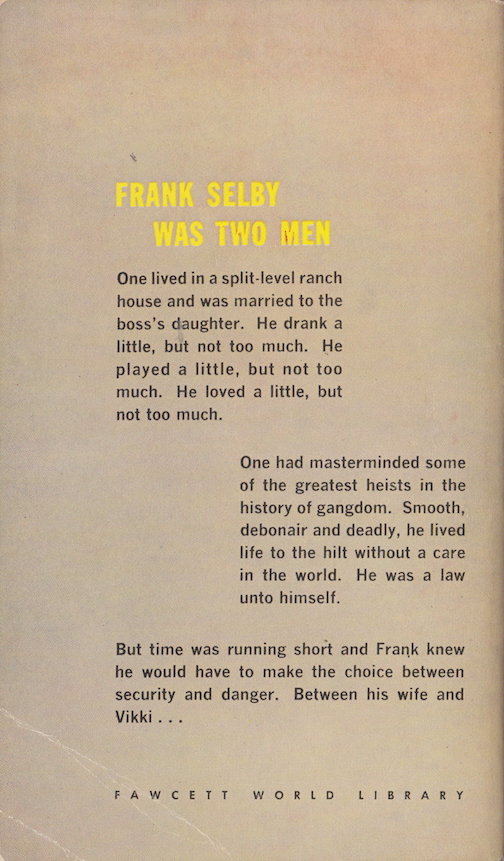George Garvarentz's music for Panic Button is the 884th
Soundtrack of the Week.
Maurice Chevalier and Jayne Mansfield made a movie together? Apparently so. The "Opening (Generique)" is a fairly aggressive jazz number, beginning
with timpani solos before swinging into a high-energy complicated
melody featuring female voice singing wordless vocals, sometimes in unison
with horns. Then it settles down into a more easy-listening mood, followed
by a bluesy section. "Flight to Rome" sounds like movie for an industrial film, with strings and
horns soaring and blaring over a fairly uptempo jazz pulse. From Rome it's on to "Venezia (Venice)", in which Garvarentz acquits himself
quite well in a Mancini-ish vein, with a nice melody played by strings
backed up by a gently swinging rhythm section. The orchestra then breaks out a bunch of light and chirpy sounds for
"Traffic in Rome", another mid-century arrangement that's sort of fast-paced
and woozy at the same time. A different mood, something almost balletic, orchestral without any jazz
vocabulary, comes next, in "Un Clochard Ma'dit", which sounds like it
go well with a Christmas celebration scene. "Mediterranean Samba" is a bit like the song "Brazil", and has a lively,
muted, staccato, electric guitar galloping through it. More lofty strings and horns, this time over a fast walking bass and
some occasional comic interludes, keep energy up for "The Chase" while
"Change in Venice" mostly has stereotypical "musical sounds of Venice". Surprisingly, "Love Is Wonderful" isn't a love ballad but more a nimble sort
of dance number, perhaps a foxtrot? The jazz combo gets to cut loose for "Panic Button", with the whole band
wailing over some really good grooves. A very late night feel pervades the slow jazz/blues "Venezia (Nite Club)",
which even has an electric guitar solo. "On the Balcony" is more or less a take on "classical music" for just the
strings and plays
around with counterpoint and fugue. After which the "Finale" reprises the "Opening".
2025 November 21 • Friday
And here's another Gold Medal paperback, John McPartland's I'll See You in Hell!
It's a short, intense blast of sex and violence that doesn’t match its title as well
as it does the first half of the front cover blurb: “Hell was a small town”.
2025 November 19 • Wednesday
It's Gold Medal paperback time again! This one, Return to Vikki by
John Tomerlin, was way above average!
Photo covers are usually a disappointment but not when it's Eva Lynd! The
front-cover text isn't actually accurate, though. The back cover text
is also not quite what you'd get from the book and it also manages to
spell the main character's name wrong.
Then one day he'd had enough and he split and tried to disappear
into a normal, suburban, middle-class life in Ohio, married to a
woman named Nancy. But his old boss, a sadistic true-crime nut with a fish tank of man-eating
piranhas (I know, not a real thing), finds him and drags him back to
New York for what should be the ultimate heist: a bank is changing locations,
which means that the entire contents of the bank will be loaded
onto trucks and driven to the new spot. The mission: steal the bank. Shelby doesn't want to be there and doesn't think it's possible. He does hook up with Vikki again, even though he left her in the lurch
kind of badly years ago. And some of the other gangsters in the
syndicate don't like Frank too well. But where there's a will, there's a way. This was a great, well paced
heist thriller with lots of atmopshere and nice touches. Shelby seems like a typically doomed criminal hero in a fatalistic
scenario but this is also around the time that the conventions
of the genre started to change, leading to a series of Richard Stark
"Parker" books instead of just one that had Parker arrested
or killed at the end. So there are a few surprises and it's a lot of fun to read. The first line is "Later he would think of this day and make of each
swift second—each swift, normal, humdrum second—a separate memory".

2025 November 17 • Monday
The 883rd Soundtrack of the Week is Gerald Fried's
music for A Killer in the Family.
The "Opening Titles" track presents the main theme that's heard many times.
It starts with electric guitars playing a mellow groove, soon joined by a horn
playing a bucolic Americana theme. This is soon interrupted by a crescendoing
dissonant orchestra figure. This happens several times, the guitar and horn
creating something safe and pleasant and then this ominous music of dread
comes washing over it. The next cue, "Brothers", explores the pastoral, "nice" part of
the main theme at greater length and while it builds intensity
it stops short of the dread and tension. Then it's the flute and clarinet's turn to pick up the sweet main theme
for "Mother and Son", which takes a turn for the serious and threatening
at the very end of the track, with the orchestra building up sounds of menace. The menace is constant in the grim, low-register "Entering the Prison",
which is similar to some of the music Fried wrote for the Star Trek
television show. "Prison Break" is an explosion of action with insistent percussion and stacked rhythms,
horns blaring and strings sawing, with some precisely placed electric guitar
lines. Some kind of synthesizer comes in with some woozy tones worthy of the Radiophonic
Workshop for "'Judge Not That You Be Not Judged'/Desert Massacre",
which goes through several different zones, mostly sounding like
people in extreme danger. The next cue, "'Get Me the Sheriff's Office'", is a driving, urgent piece
that grooves in a tense way with a cool melody written for the horns. Piano and maybe harpsichord introduce "'We Have You Surrounded'", which
uses low tones and snare drum to create a feeling of suspense. Then the orchestra
produces pulses of harmonic movement and again there's nice lyrical writing on top.
After this comes a more spacious, textural part with synth and timpani and
other instruments for an interesting and unusual blend. While "Running the Roadblock" presumably could just have been a straightforward action
cue, Fried starts it off with modern, dramatic underscoring before unleashing
his ensemble in full rock-beat mode with writing for the horns that's
up there with David Shire's The Taking of Pelham 1-2-3 music. Things wrap up with "End Titles", which restate the theme, and then an alternate
take of the "Opening Titles".
2025 November 14 • Friday
Clifton Adams's A Noose for the Desperado is a sequel to his The Desperado,
a book that Donald E. Westlake tagged as an influence on his Richard Stark "Parker" novels,
and as an excellent book in general. No disagreement from me there. Westlake also said that the second book was so bad that it almost ruined the first one,
and on this matter I really have no idea what he's talking about. I thought it was really good
and a worthy follow-up!
Tall Cameron isn't too much older in years than he was in the last book,
but his character has matured considerably. He's still bitter about his one-way ticket
out of the future he had dreamed of before he became an outlaw. He also
still has his unusually strong and focused anger, a quality that often saves his life
and even more often ends the life of someone else. In this book, which has some slight but interesting similarities to Westlake's Killy,
Cameron ends up in a hellish Arizone town called Ocotillo, in which a corrupt US Marshall
and a crime boss control a small army of gunmen to rob caravans of smugglers carrying
silver from Mexico. Since both perpetrators and victims are criminals, and an actual US Marshall is on the side
of the raiders, they can do this with impunity. But the boss, Bassett, pays off his
soldiers with worthless tokens instead of a share of the real money. The tokens can be
used to buy things in town but have no real cash value. So no one can ever leave. There's
no possibility of getting enough real money to move on and find a safe haven somewhere else. Which is, of course, what Cameron wants to do., In the process he finds himself caught in
a couple of different crossfires, one physical and the other psychological. The physical one involves a local Mexican woman named Marta. Both the US Marshall and another
character, a Native American killer that everyone is scared of, are in love with her
and would kill anyone who looks at her. Marta attaches herself to Cameron right away,
seeing in him a chance for escape and also an opportunity for some kicks. (Adams's use of alcohol and sex in this book are enough to make you wonder what
a Cornell Woolrich western might have been like.) The psychological/emotional crossfire comes when Cameron establishes relationships
with an older, drunk Civil War veteran and a younger man who has just fled Texas
for almost the exact same reason Cameron did in the first book. Clearly these characters represent Cameron's past and possible future, as well as as possible
doom and redemption—whatever redemption might look like for someone like Cameron. As in the first book, the writing is excellent and the book has a lot of vivid action
and brutal but understated violence. It's a real page-turner and a reminder of how
exciting westerns can be. If I had read this book way back when, I could have asked Westlake about it and why
he was so down on it. I suppose that'll have to remain a mystery. The first line is "I scouted the town for two full days before going into it".
2025 November 12 • Wednesday
Artificial Condition is the second book in Martha Wells's
Murderbot Diaries series and it's just as enjoyable as
the first one was!
This time around our SecUnit hero is trying to find out what really happened
in that past disaster when all of its clients were killed, maybe
by our SecUnit hero itself. As a rogue murderbot it has to find ways to travel stealthily
among humans and this is pretty difficult since
it doesn't look or move like a human. Since, you know, it isn't one. A curious thing about these books is that they're so engrossing and enjoyable despite
lacking the kind of tension and conflict that almost always drive
such books. Murderbot is pretty much always
prepared and more powerful than anyone and anything it comes into conflict
with—excepting ART, of course, but ART is immediately and reliably on
Murderbot's side. We're really here for the main character's voice, endlessly exasperated
and pessimistic. This is sci-fi action at its most amusing and, well,
gentle, despite high body counts and scenes of violence. As part of this adventure Murderbot ends up intervening in a conspiracy
to murder some human scientists. It does revisit the scene of the
massacre that's been haunting it as well, but there's still more
mystery surrounding it. I hope Wells can sustain this level! The first line of Artificial Condition is "SecUnits don't care
about the news".
2025 November 10 • Monday
Tangerine Dream did more movie soundtracks than I realized. 1987's Shy People
is one of them and also the
882nd Soundtrack of the Week.
About three and a half minutes of atmospheric yet subtly lyical synth textures
go by before Jacquie Virgil comes in singing vocals for the title track. Actually
she starts a little earlier than that, wordlessly, but the lyrics come in later.
It's a beautiful, soulful and haunting track with hints of bluesiness to it. A shakuhachi sound (I don't think it's a real shakuhachi) opens "Joe's Place",
which leads to a slightly ominous mood before shifting to a more angelic
cathedral sound. The tempo picks up and you'll probably start tapping your toes to "The Harbor",
which features some synth electric guitar flourishes and lyrics sung by Diamond Ross. "Nightfall" is a melancholy synth instrumental that falls somewhere in between
a 1970s Doctor Who Radiophonic Workshop piece and a Julee Cruse backing track. But then we get another groovy, swaying pop number with vocals by Jacquie Virgil again.
This is a nice, lilting song, peppy but restrained. Percolating, Philip Glass-ish synth lines run through "Civilized Illusions" while some
breathy musical figures provide a counterpoint to more sustained and solid melodic
ideas. Drums come in to provide a driving pulse about halfway through. The next track, "Swamp Voices", is a still, solemn synth atmosphere
and is followed by another restrained, quiet, textural track, "Transparent Days". To conclude the album there's an instrumental version of the title track, then three bonus
tracks. "Swamp" is a mysterious and slightly menacing mood piece, all long tones and
light percussion. "Nature" is a more uplifting, heavenly-sounding number, similar
to the end of "Joe's Place". And finally, "Going to Town" is actually kind of a rock number, with energetic
drumming and insistent synth lines suggesting some kind of dramatic effort or
confrontation.
2025 November 07 • Friday
The flip side of Jay Flynn's Drink with the Dead is William Woody's
Mistress of Horror House. The two were published together
as an Ace Double Novel.
This definitely wasn't great but it was different. It's about a private
detective named Houston McIver who plies his trade in El Paso. He formerly worked with border police and still has a lot of contacts
from those days,
on both sides of the law. The story begins with extremely familiar genre conventions. McIver
hasn't had any business in a long time and is wondering how
he's going to pay his rent, when a beautiful woman walks in
and hires him. Someone pretty much immediately starts trying to kill him
and he follows his client back to her house, a stately home
that's belonged to generations of her family, the Macgruders. This is the "horror house" of the title but it's not actually
horror in any way. This book could have been nudged a bit to
deliver some eerie horror house type of stuff but it wasn't. Readers might feel like Woody is just making this up as he
went along, and wrapped things up at the end really quickly. The cover illustration, which is pretty nice, gives away
what was probably supposed to be a big reveal at the end. The Siamese cat is an interesting element, too. What makes
this story stand out is that McIver has a pet Siamese cat
and he brings it with him on his case. Just puts it in
his pocket and then the cat is one of the characters
in the house, interacting with everyone else all the time. I'd never seen that before. But it's a fairly tepid
book though agreeable enough. The first line is "The new gold-leaf sign on my office door
had set me back seventy-five bucks and I was very proud of it".
2025 November 05 • Wednesday
Jay Flynn is a fun author to collect. He wrote as Jay Flynn or J. M. Flynn
and maybe as Jack Slade.
He was quite a character, as one gathers from
Bill Pronzini's recollection
of him. Pronzini tagged The Action Man as Flynn's best book. I liked it a lot.
Pronzini also said that Drink with the Dead was one of his favorites
of Flynn's Ace novels, and that inspired him to co-write his own modern-day
bottlegging story. I also enjoyed Drink with the Dead!
It's about a T-Man who goes undercover to bust an illegal booze racket. Someone's
making good quality spirits and distributing it all over California, taking
a bite out of legitimate distributors profits and, of course, cheating the
government out of tax money. Agent Kon Jensen, of Danish descent, follows his best friend and fellow agent
who's just been murdered on the job in a northern California coastal town. Nobody would ever accuse Flynn of being squaemish or restrained, so there's
a lot of sex and violence for a 1959 novel here. The books opens with
Jensen, accused of murder, being given the third degree by the Assistant DA and the cops. After proving to the reader that he could wipe the floor with these guys if he
wanted to, Jensen is locked in jail after getting hit with a cheap shot. All this
before we know much of anything that's going on. Flynn takes us back to the beginning of the story after that, where we meet
Jensen's boss and the soon to be murdered fellow agent. At home and on the case
Jensen is able to get really close to beautiful women who don't like it when
he starts something without finishing it. There are gangsters and crooked cops as well as an honest cop who
suspects what Jensen is up to. This is undiluted mid-century hardboiled crime
fiction with no apologies. There's even a twist at the end that allows for
a Spillane-like moment (which Hammett had done first). Reading this book is like watching a black-and-white crime movie
from the '50s, if such movies had been allowed to be rated R. I'm looking
forward to reading more from Flynn.
2025 November 03 • Monday
Paris, Texas "is widely considered one of the greatest films ever made",
according to Wikipedia. Alas, this is an opinion I do not share. Despite having a great cast and nice photography,
it didn't do anything for me. I found it to be really boring and didn't even
make it to the end. It's a long movie, almost two and a half hours long. That's
not always a problem but it felt very long to me. Way too long. But one of the other things it has going for it is
Ry Cooder's simple yet moving music, which is the
881st Soundtrack of the Week.
Cooder does a lot with just a very few notes. With some drony noises in the background,
he'll draw out some tones with a slide on an acoustic guitar, letting them hang
and then switching to some harp-like plucked notes. This how the main theme goes, as well as, well, the rest of it. There are some
slight variations but that's the general idea. "Canción Mixteca" departs from this for the conventions of Mexican folk music
and "No Safety Zone" has an eerie middle section that sounds like it might involve
prepared piano and musique concrète. There's a gesture in a direction of a more straightforward Americana sound
in "Houston in Two Seconds" and "She's Leaving the Bank" but mostly it
sticks to something like the establishing themes. Despite being so spare and repeating itself so much, it's not boring at all.
It has a hypnotic pull and a quiet intensity. Perhaps the movie has this
for a lot of people, but not for me. Fans of Loren Mazzacane Connors would like this record. The track "I Knew These People" includes dialogue from the movie.



 APPEARANCES
APPEARANCES